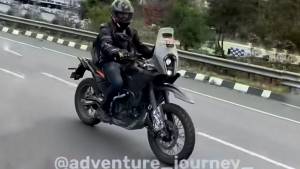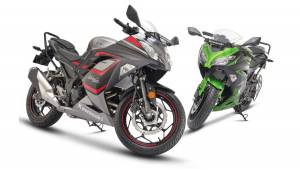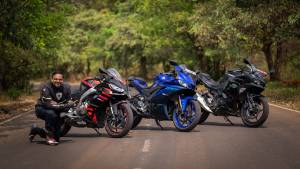2013 KTM 390 Duke India road test
Too fast, too fast, too freaking fast my brain is screaming, but it is as if my right wrist has become disconnected from my brain. Welcome to the world of the Yamaha RD350. India's pinnacle of performance motorcycling for, like, ever.
The time has now come to turn the volume up to eleven. I am finally riding the KTM 390 Duke on Indian roads. In my head are the exact same thoughts that were screamed out by my poor brain when I rode the Yamaha for the first time. Too fast. Too freaking fast.
But let us not get ahead of ourselves. Let us approach this test as adults, shall we?
Styling, build and finish
Yes, it does look like a flash 200 Duke and that has to be a bit of an issue. Lots of people on the road commented on this and not one was happy about the resemblance. In effect, the 390 shares the 200's silhouette and plastics and though the tank is slightly larger and the seat slightly lower, stickers and paint aside, there is no distinction. Bajaj, of course, has played this game before â" the Pulsar 150 and 180 were all but identical for years together apart from badging and the rear tyre, right?
What I was surprised to note is that while finish levels are similar to the 200, the 390 looks a smidgen more ragged in appearance. The reason is wiring. Black lines run from the rear brakes, coil around the trellis and another coil hangs outside the trellis under the right front of the tank. The cables, to me, disturb the otherwise clean, spartan look. The contrast to the orange trellis and the orange wheels only makes the wiring more visible.
 The orange trellis frame is identical to the 200 and the only difference in chassis terms are ABS-equipped brakes and the amazing Metzeler tyres
The orange trellis frame is identical to the 200 and the only difference in chassis terms are ABS-equipped brakes and the amazing Metzeler tyres
Does the paintjob stand out? It does. People notice this flashy looking thing quite easily and some aren't above hinting that this is a 200 wearing 390 paint either.
Upshot? The 390 looks identical though clearly more flashy compared to the 200. You may not like it, but you will have to live with it. Or wait for the RC390 to arrive.
Handling and braking
The 200 and the 390 also share their chassis. The differences are in the tyres â" the MRFs give way to imported (same size) Metzelers. And in the brakes, the 390 gets Bosch's latest generation of ABS as standard. With double the power, you might think the 390 doesn't have enough chassis. You'd be wrong.
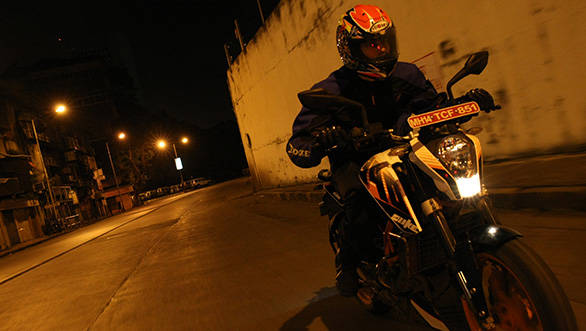 What really impresses is how confident it is when the surface is half-wet, half-dry and has some dirt on it as well
What really impresses is how confident it is when the surface is half-wet, half-dry and has some dirt on it as well
As has become usual with Bajaj, they seem to launch their most exciting motorcycles right in the middle of the rains and that makes testing much harder. After all, how hard can you push a bike in a wet corner, right? Turns out, the 390's Metzelers are extremely happy in the wet â" the 200's MRFs were already great â" and the 390 is extremely sharp and grippy around corners. Turn in is nearly as instant as on the 200, there is more grip to play with mid-corner (which means either more speed or more lean, take your pick) and on the exit, there is an even stronger sense of hook-up than the MRFs. What really impressed me is how confident it is when the surface is half-wet, half-dry and has some dirt on it as well.
On the brakes too, the 390 is excellent and for most people, the ABS is a complete no-brainer in terms of its capability to save your skin. However, when we started brake testing we kept feeling that the ABS was coming in too early. This is probably good for new riders but will be interference for people with more skill. That niggle aside, the 390 is happy to dig its front tyre into tarmac on the brakes, and the ABS successfully prevents the rear wheel from lifting off while ensuring fast, hard stops.
Ride quality
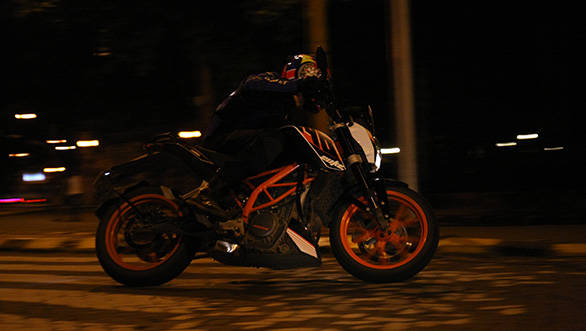 Over really bad roads, you either have to slow right down or work around a jittery-skittery feeling while the 390 hops about trying to absorb the punishment
Over really bad roads, you either have to slow right down or work around a jittery-skittery feeling while the 390 hops about trying to absorb the punishment
The suspension settings from the Austrian spec to this Indian one have changed. Our damping is a bit softer to accommodate our roads. But I've chosen to deal with the ride quality in its own section because the 390 is extremely stiff and sporty which will make it harder to accept for some. There is no getting away from the fact that faster, sharper machines have to be sprung stiffer. In feel the 390 is a lot more like a sportsbike than a stiffer 200 Duke. Good roads and corners don't trouble it, but bad roads are another thing altogether. Over really bad roads, you either have to slow right down or work around a jittery-skittery feeling while the 390 hops about trying to absorb the punishment. We never felt that we were about to damage the wheels or anything, but placid and calm over bad roads the 390 is not.
Engine, performance and refinement
The reason why there are no 1600cc singles is that single cylinder engines vibrate. And on the 390, the first sign that you have a large engine are some vibes at idle on the handlebar (present but not disturbing) and a bit more bass in that identifiably KTM engine note. Thankfully, the vibes remain pretty subdued once you get going but this isn't as smooth an engine as the 200 was. On the economy tests, steady 80kmph on the highway gave me a gentle tingle in the fingers though higher speeds felt better. 100kmph (5,000rpm in sixth) was smooth and comfortable.
 Once the revs cross 4000rpm, you are at the beginning of an epic mid-range
Once the revs cross 4000rpm, you are at the beginning of an epic mid-range
But the story of the 390 is how it makes its power. Like a big motorcycle, it chugs and lugs and feels a bit lumpy low down. It smoothens out past 3-3500rpm which means sixth is nearly impossible to use in the city. Unlike the 200, the 390 requires far fewer shifts but needs you to ensure it is in the right gear; it requires more precision. Once you figure that out, trundling along at low speeds is effortless.
Once the revs cross 4000rpm, you are at the beginning of an epic mid-range. Just wind the throttle on and the 390 gathers speed with such ease that you will smile broadly. Only later will you notice you are almost always at least 20kmph faster than you think. Uh oh. Only past 6500-7000rpm does the engine note gain the aural urgency (though not the stress) that underlines its terrific pace.
How terrific? The Yamaha RD350 (39PS, US-spec) was supposed to hit a 100kmph in about 7 seconds. The 390 does that in 5.6s crossing 60 in just 2.7. We saw an indicated top speed of 172kmph (90kg rider, prone) though the Vbox confirmed that the actual speed was 168.5kmph. That is properly, respectably fast! Realistically, 130kmph is almost too easy to get to (11s from a standing start!) and as much as 150kmph is possible without requiring too much space or effort. As in massively, massively impressive.
We did slow down for the economy runs and in the city the KTM returned 26kmpl while out on the highway economy rose to 34kmpl. These aren't Hero Splendour figures, but eminently livable with.
Verdict
We were looking forward to testing the 390 Duke in India ever since our first taste in Austria and the upshot is that it's a great little motorcycle. Little is important because unlike, say the Ninja 300, it doesn't feel like a large or big machine at all. It feels small and sharp, more scalpel than machete. And therein lies the question of whether you should buy it. The ride quality you will learn to live with and the rock-hard seat will stop bothering you six months in (or you'll give up and change the foam). The performance is unprecedented, the economy is good enough to not be a headache and all that. But the question is can you live with the 390 every day or not.
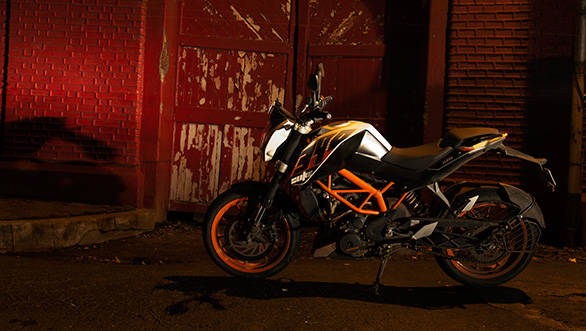 The performance is unprecedented, the economy is good enough to not be a headache
The performance is unprecedented, the economy is good enough to not be a headache
Let me explain. As you know the 200 can be ridden calmly through traffic but it doesn't really feel like it is in its element. The 390 is vastly better at this as long as you keep the revs at about 4,000 or higher. But when you light the wick, the 390 goes mental gathering speed with such frightening ease that I think new riders will find it by turns, thrilling, scary and then possibly evil. The 390 is playful but it isn't a plaything. It will not take to being ridden fast casually. Riding it quickly will require the rider to pay full attention and if you aren't ready for that kind of commitment you'll find the 390 a bit of a challenge to live with every day.
At about Rs 2.1 lakh on-road most places in India, the 390 Duke is a brilliant motorcycle, the likes of which we haven't seen in decades. Which makes it eminently worth buying. But remember that it requires both skill and respect. Because it is fast, so freaking fast.
